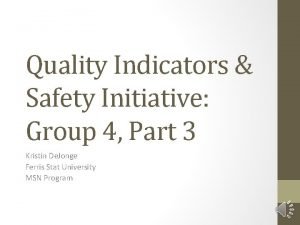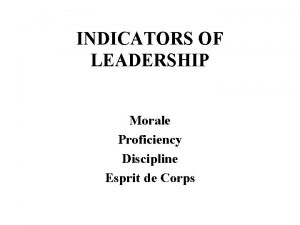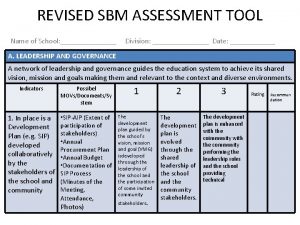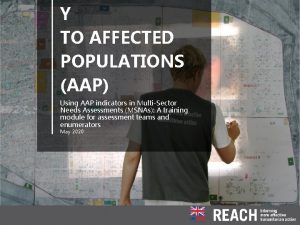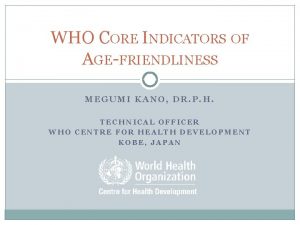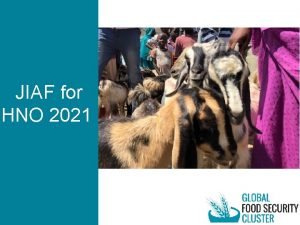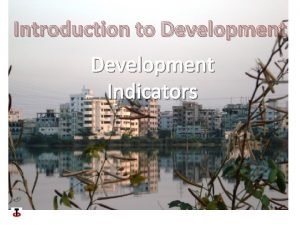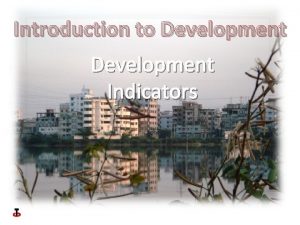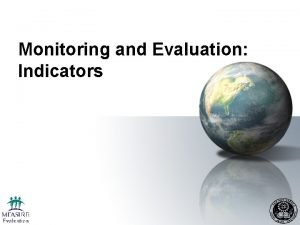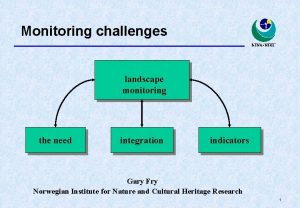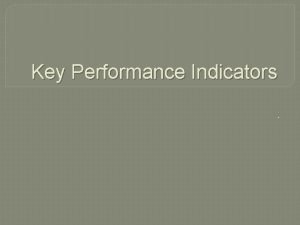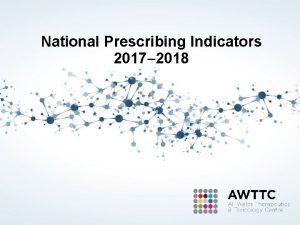9 MONITORING ANDEVALUATION 9 1 Monitoring Indicators 9

















- Slides: 17

9. MONITORING ANDEVALUATION 9. 1 Monitoring Indicators 9. 1. 1 Outline Performance Monitoring Framework The program will be managed through results’ approach with a special focus on the team. High performance team work will be initiated and sustained among different specialized individuals and FBOs groups. This will lead to greater coordination, collaboration and communication. Team spirit will be based on real issue after a baseline pre-assessment. Management by results will also include taking care of cross-cultural differences among the team members, FBOs and villages, reduction of complains, project cost reduction, increased skill utilization, increased earning and reduction of backlog.

9. 1. 2 Major Indicators Four main indicators (input, output, process, and impact) will be used to monitor the project (Table 7).

9. 2 EVALUATION GRSP will verify the indicators stated above to ensure that the project is carried out as outlined and that the objectives are attained. Community-based organizations, for example, different churches and mosques, church choirs, association of church elders, youth groups of churches, village development associations, and so forth will be involved in the execution of the project. Promoters will ensure that the project is carried out to the satisfaction of the different churches and mosques.

Data collected in each sub-division by the divisional supervisor will be disseminated to churches as well as provincial and national church head-quarters and the NACC for any strategy modification. On a quarterly basis the coordinator will send summary report to the NACC and the Ministry of Public Health for central analysis and to be used for HIV/AIDS prevention, care and mitigation.

9. 3. How the beneficiaries will be involved in monitoring and evaluation Regular data collection will include questions related to FBO satisfaction. Responses to these questions will allow supervisors and the principal investigator to up-grade or adjust strategies and priorities over the course of the project implementation. Confidentiality of the participants will be highly prioritized when collecting and disseminating data.

10. EXPECTED RESULTS AND IMPACT 10. 1 Expected Results FBOs shall be mobilized to respond to the needs of orphans and vulnerable children (OVC) and people living with HIV/AIDS (PLWH). There will be a resultant decrease in stigmatization, prevention, care and mitigation of HIV/AIDS and other STIs. PLWH will be involved in the project and will receive adequate support from their FBOs. There shall be some degree of poverty alleviation with OVC needs provided for by the CBOs. There will be provision of jobs to various categories of people in the villages including PLWH.

10. 2 Impact of the project The net impact of this intervention program is to reduce the spread of HIV/AIDS in the country which will eventually lead to poverty alleviation among the population. Since poverty alleviation involves using the principal asset of the poor namely: their force, the economic force of the people especially the youths will be ameliorated. AIDS is a disease that swallows up the meager resources of the under privileged shutting them up in the vicious cycle of poverty; which if controlled, they could live healthier, longer and more productive lives.

11. SUSTAINABILITY OF THE PROJECT For the continuity of the project, the following measures are envisaged: 1) Institutional reinforcement of village FBO activities In each intervention village, village FBO committees will be organized and will be engaged and responsible in all phases of the project from the beginning to evaluation. These FBO structures will be assisted for better organization, setting of functional rules, management tools, training of executive members, etc. At the end of the project, each FBO will have a participatory structure capable of analyzing and solving problems related to HIV/AIDS prevention, care and mitigation and other STIs.

For the continuity of the project, the following measures are envisaged: 2 ) Transfer of competence to the FBOs There will be capacity building of the clergy, AIDS orphans, animators and promoters to execute, manage and administer HIV/AIDS prevention, care and mitigation programmes. The animators and interviewers will continue to carry out HIV/AIDS prevention, care and mitigation and I E C in FBOs in the villages when the project comes to an end.

For the continuity of the project, the following measures are envisaged: 3) Participation of beneficiaries FBO members who are AIDS orphans and PLWH will be trained in income generating activities. AIDS orphans and PLWH will be recruited as interviewers, animators, promoters, etc. Hence, providing jobs for them, which no doubt, is another way towards poverty alleviation. Other FBO members will pass on the information to other villagers and their young ones who are not with them in the villages, which is another way towards HIV/AIDS prevention.

For the continuity of the project, the following measures are envisaged: 4) Integration of the program into FBO training schools: The intervention will be introduced into seminaries, bible schools and other FBO training centers so that pastors, priests and imams graduating from these schools will be trained in the type of sermons they should give in FBOs vis-à-vis HIV/AIDS prevention, care and mitigation and other STIs. The capacity of these institutions will be increased to fight HIV/AIDS.

12. BENEFICIARIES OF THE PROGRAM The activities developed in this intervention program are meant to scale up the fight of HIV/AIDS in the study area. The immediate beneficiaries will include 226 452 and 119 921 inhabitants of Donga- Mantung and Menchum divisions respectively. This will include 108 major villages of the two divisions. Subsequently, 1 307 369 inhabitants of the North West and 15 million Cameroonians will benefit from the project. The following tribes: Wimbum, Fulani, Hausa, Mfumte, Yamba, Mbembe, Bessa, Nchanti, Aghem, Essimbe, Nso, Nyos, Esua, Moghamo, etc. , will benefit from the intervention.

13. RISKS AND LIMITATIONS TO BE CONSIDERED Some risks will be taken in the execution of the project such as: 1) The bad nature of the roads in the North West province in general and the Donga-Mantung and Menchum divisions in particular especially in the raining season. Bicycles and motor cycles will be used by animators and promoters while fourwheel drive vehicles will be used by supervisors. 2) Slowness in administrative procedures at certain levels in the administration. The administration will be carried along to reduce this risk.

14. BUDGET 14. 1 Budget summary Table 5: Estimated summary budget (in thousands of FCFA) of the intervention from January 2004 – December 2005

References Bambu, E. (2003) HIV/AIDS in Nkambe health district of Donga-Mantung division (personal communication). CIDA project planning and implementation. Results-based management in CIDA. Resultsbased management. http: //www. kivu. com / CIDA Document conceptuel ACDI-Cameroun « SIDA – Cameroun » A – 031934. Pages 1 – 11. HIV / AIDS. http: //www. Cameroun. Plus. com

References Provincial Delegation of Public Health (1996). Leprosy situation in the North West province in 1996. Leprosy control unit, Bamenda, N. W. province, Cameroon. Pages 1 -12. Meekers, D. and Calves, A. E. (1997). “Main” girlfriend, marriage, and money: the social context of HIV risk behavior in Sub-Saharan Africa. Health Transition Review, 7(supplement) 361 -375 Nsagha, D. S. (2003) The victories and vexations of the AIDS story: The views of an African. Results of stakeholders’ workshop organized by Voluntary Service Overseas (VSO), Yaounde, Cameroon

References Silvertein, K. (2003). AIDS could Follow African pipeline. CDC news updates. June 25 The National AIDS Control Committee (NACC) (2003). Epidémiologie du VIH/SIDA. Torchbearer Foundation for Missions, Reconciliation and Development in Cameroon (TBF-Cameroon), August 15 th 2003 conference, Nkolbisson-Cameroon UNAIDS Press Release; 25 June 2003. http: //www. unaids. Org World Bank. Cameroon: Diversity, growth and poverty reduction. Report N° 13167 - CM, 4 th April 1995. Zekeng, L. (2003). Open house forum on HIV/AIDS at the Yaounde City Hall. Guest-the World Bank. Camsante 17: 7
 Importance of physiological indicators
Importance of physiological indicators Chapter 7 sports and entertainment marketing
Chapter 7 sports and entertainment marketing Redox indicators
Redox indicators Insider threat training slides
Insider threat training slides Titration jokes
Titration jokes Nursing sensitive indicators
Nursing sensitive indicators Present continuous indicators
Present continuous indicators Morale proficiency discipline and esprit de corps are
Morale proficiency discipline and esprit de corps are Ged high impact indicators
Ged high impact indicators Chromophore theory of indicators
Chromophore theory of indicators Sbm assessment tool
Sbm assessment tool Msnas
Msnas Megumi kano
Megumi kano Jiaf
Jiaf Indicators of potential workplace violence
Indicators of potential workplace violence Indicators of past simple
Indicators of past simple Performance monitoring and coaching form 2021
Performance monitoring and coaching form 2021 Model performance indicators wida
Model performance indicators wida





